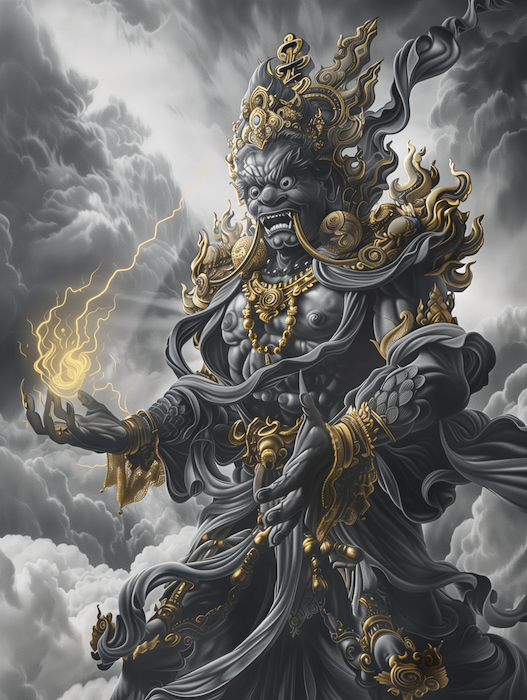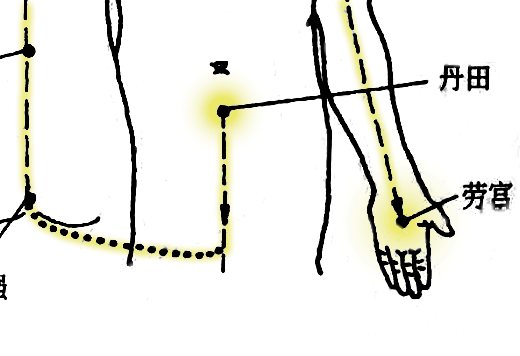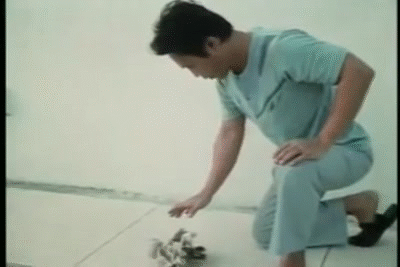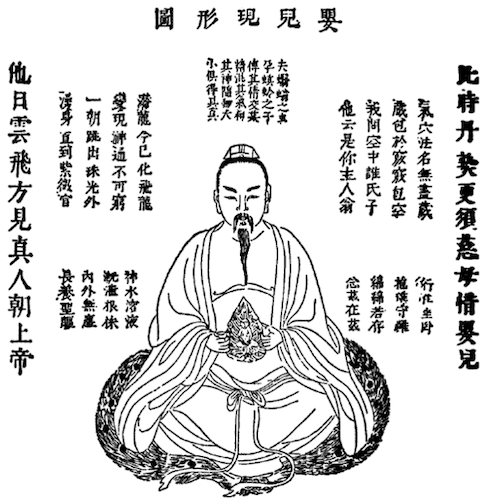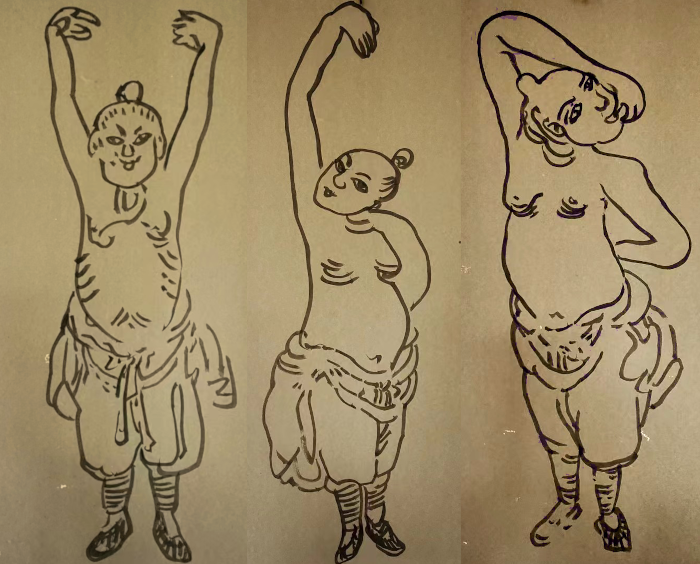Neigong
-
Qi-charged Tea and Emitting Qi into Substances
A specialty of the style of classical Chinese medicine passed down within the Gengmenpai lineage is their use of special pills (dan 丹) that have gone through a special process in which an adept practitioner emits their own qi and injects it into the medicine to greatly enhance the medicinal effect. I have no doubt that it was this extra touch given to the medicine that caused me to have the experience that I did the first time I took several of their signature huaxuedan (化血丹) at once years ago. What is interesting, is that it was explained (and in some cases demo’d) to us how qi can be emitted…
-
Vajrapani: the Protector of Shaolin
Vajrapani is a deity with special significance for Shaolin Temple who is rich with symbolism. Could he also represent the skill of electric-like qi emission? As discussed below, this idea may not be too much of a stretch. Vajrapani is the patron Bodhisattva and protector deity of Shaolin Temple. In Chinese he is called Jingang Shou Pusa (金刚手菩萨), literally, “holder of the vajra.” The vajra is both a symbolic ritual object and a weapon, and could be translated from Sanskrit as either “thunderbolt” or “diamond.” Vajrapani is a deity that is not only seen as a protector and source of strength, but also represents some of the most interesting juxtapositions…
-
Fagong Practice: Assisted Faqi, Practice Moving Non-living Materials
The skill of electric-like qi emission (fagong 发功) is not something you encounter every day. It is a level of skill that typically takes years to attain and is often aided by various “boosts” and adjustments from a master as the student gradually develops. Practicing fagong “with assistance” is sort of like a way for a student to begin to practice this skill with “training wheels,” so that they can start to develop the necessary control and mind-body coordination needed for this never-before-used function of their body. In light of the above, the majority of western students who are practicing this skill (as taught, for example, within the Gengmenpai and…
-
Modern Science on Training our Connective Tissues (Fascia, Tendons, etc)
The “tendon” system (here broadly referring to all stringy connective tissue) and the meridian system of the body form a yin-yang pair. Developing the tendon system is a key aspect of neigong training as it enriches and unblocks qi flow throughout the body, promotes organ health, immune health, and various other aspects of health. Modern research continues to uncover many interesting facts about the connective tissues of the body. While I don’t feel that legitimate, tried-and-true systems of Chinese neigong necessarily need the validation of modern science; it is nonetheless useful to study the topic from different perspectives. Fascia (thin, fibrous connective tissue) fills our body from head-to-toe forming a…
-
Yijinjing Qigong and Practice Essentials 易筋经气功与修炼要领 (translation)
The following is my translation of an article (along with the original in Chinese) written by Gengmenpai’s 耿门派 Dr Wu, the successor to Dr Jiang Feng. The article begins by discussing some general points about qigong/neigong practice, the meridians and orbits, and then continues with a brief discussion of waiqi emission (fagong 发功). Notable are the alternate routes for waiqi emission that are outlined along with schematic images, including two routes that are different from the basic one that beginners usually start with when first learning to practice fagong. Written content of this nature from one of the high-level Gengmenpai practitioners is very rare, making this something worthy of translation…
-
My Experience Practicing Waiqi 外气 Emission (Fagong 发功)
In lineages such as the Shaolin Gengmenpai 耿门派, many if not most of the advanced practitioners practice a style of Classical Chinese Medicine that involves various forms of qi emission. Most who have visited them for treatment have experienced their electric-like “waiqi” 外气 (external qi) emission, the experience of which feels like you are being zapped by a fairly powerful electrical current. If, for example, you receive this qi emission (faqi 发气) up one of your arms, it is powerful enough to cause all of the muscles in your arm to involuntarily contract, until the person emitting pulls the qi back in and “turns it off.” In practicing the neigong…
-
What is the difference between Qigong 气功, Neigong 内功, and Neidan 内丹?
Summary: We should be wary of narrow definitions of these terms applied broadly as they can refer to many things and can often overlap or be interchangeable in many contexts. “Neigong” and “Qigong” are basically synonymous and are umbrella terms for a wide range of energetic practices that cultivate the “post-heaven” qi 氣 (houtian zhi qi 后天之气) of the body. From what I have seen, these two terms seem to be treated synonymously in many, if not most, Chinese internal arts circles, although Western internal arts circles are increasingly distinguishing them in specific ways. Neidan differs in that it is a specific (yet still vast) genre of practice that seeks to…
-
Understanding Qi
Summary: Qi is the fundamental stuff of existence according to classical Chinese thought. It is the living, flowing, transforming substratum of existence encompassing everything from matter to energy to consciousness and more. It needs to be understood within the context of classical Chinese thought and should not be cut-and-pasted out from its native philosophical system into other systems of thought lest it simply become some sort of misunderstood “magical energy.” The Three Treasures (Jing, Qi, and Shen) are important concepts for understanding the body in relation to Chinese internal arts practices. While they are all ultimately just Qi (and the whole of the human body-mind is ultimately also just Qi),…
-
What is Yijinjing 易筋經?
Yijinjing 易筋经/易筋經 refers to a collection of methods of powerful Chinese neigong 内功 (“internal skill”). Legend has it that it originated from the Indian monk Bodhidharma (Damo 达摩) who came to China and founded Chan 禅 Buddhism (the form of Buddhism which later became known as Zen in Japan) at the Shaolin Temple. In fact, neigong containing the Yijinjing principles and signature movements can be found throughout China within various traditions. The word Yijinjing consists of three Chinese characters: Yi 易: The character’s two components are 日 “sun” and 勿 “not.” The sun represents constancy, it was the most constant thing in one’s visible surroundings. Putting the two characters together,…
-
My First Journey to the Yellow Mountains 黄山
It was 2014 and it was the first time I ever set foot in China. I was lying in a small hotel room in the Hongqiao airport hotel, resting after a series of flights that had seemed endless. I turned on the TV in the room and saw that the movie Painted Skin (Hua Pi 畫皮) was playing, a movie in which Zhou Xun plays a seductive, shape-shifting fox spirit who relies on a steady supply of fresh human hearts to maintain her youthful appearance. Despite the movie playing, I kept thinking about what lay ahead in the coming days. The next day, I would take a flight down to…

